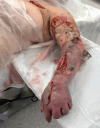Clostridium Septicum: Cause of Gas Gangrene in the Upper Extremity Leading to Proximal Trans-Humeral Amputation, A Review of Clostridium septicum
- PMID: 39524249
- PMCID: PMC11546050
- DOI: 10.13107/jocr.2024.v14.i11.4912
Clostridium Septicum: Cause of Gas Gangrene in the Upper Extremity Leading to Proximal Trans-Humeral Amputation, A Review of Clostridium septicum
Abstract
Introduction: Gas gangrene is a rare, often lethal infection of soft tissue that is commonly associated with the Clostridial species due to penetrating injuries. Case reports of spontaneous atraumatic gas gangrene due to the Clostridium septicum species are exceedingly rare. Atraumatic C. septicum is notably related to bowel pathologies, immunodeficiencies, and individuals with vascular insufficiency. The rapid progression of Clostridium myonecrosis contributes to its high mortality rates.
Case report: The authors report a case of a 71-year-old right-hand-dominant female who developed fulminant atraumatic left forearm pain and swelling. The patient was indicated for emergent irrigation and debridement (I&D) of the left upper extremity. She was later found to have C. septicum bacteremia and required multiple I&Ds including the left side of the neck and chest wall. Repeat post-operative examinations revealed no motor function or sensation distal to the elbow and she was subsequently indicated for a proximal trans-humeral amputation.
Conclusion: Although she had a prolonged hospital stay, she progressed well and was eventually discharged to a rehabilitation facility. This case report highlights the importance of early recognition of Clostridial myonecrosis as well as the need for emergent surgical intervention for the patient's survival.
Keywords: Clostridium septicum infection; Trans-humeral amputation; gas gangrene.
Copyright: © Indian Orthopaedic Research Group.
Conflict of interest statement
Conflict of Interest: Nil
Figures





Similar articles
-
Distant myonecrosis by atraumatic Clostridium septicum infection in a patient with metastatic breast cancer.IDCases. 2020 May 5;20:e00784. doi: 10.1016/j.idcr.2020.e00784. eCollection 2020. IDCases. 2020. PMID: 32420030 Free PMC article.
-
Gas gangrene with Clostridium septicum in a neutropenic patient.Infection. 2025 Apr;53(2):733-739. doi: 10.1007/s15010-024-02401-y. Epub 2024 Oct 7. Infection. 2025. PMID: 39373951 Free PMC article.
-
Clostridium septicum infections in children: a case report and review of the literature.Pediatrics. 2006 Apr;117(4):e796-805. doi: 10.1542/peds.2005-1074. Epub 2006 Mar 27. Pediatrics. 2006. PMID: 16567392 Review.
-
Cerebral Septic Emboli: A Unique Complication of Clostridium septicum-Induced Myonecrosis.J Investig Med High Impact Case Rep. 2025 Jan-Dec;13:23247096251342027. doi: 10.1177/23247096251342027. Epub 2025 May 31. J Investig Med High Impact Case Rep. 2025. PMID: 40448512 Free PMC article.
-
Simultaneous necrotizing soft tissue infection and colonic necrosis caused by Clostridium septicum.Surg Infect (Larchmt). 2011 Dec;12(6):501-6. doi: 10.1089/sur.2010.054. Epub 2011 Dec 5. Surg Infect (Larchmt). 2011. PMID: 22142321 Review.
References
-
- Larson CM, Bubrick MP, Jacobs DM, West MA. Malignancy, mortality, and medicosurgical management of Clostridium septicum infection. Surgery. 1995;118:592–8. - PubMed
-
- Schade VL, Roukis TS, Haque M. Clostridium septicum necrotizing fasciitis of the forefoot secondary to adenocarcinoma of the colon:Case report and review of the literature. J Foot Ankle Surg. 2010;49:159.e1–8. - PubMed
-
- Wiersema BM, Scheid KD, Psaradellis T. A rare trifocal presentation of Clostridium septicum myonecrosis. Orthopedics. 2008;31:274. - PubMed
-
- Chen LL, Tayban K, Caravanos C, Shaz D, Halpern NA. Necrotizing fasciitis associated with malignancy. J Am Assoc Nurse Pract. 2020;32:109–12. - PubMed
-
- Abella BS, Kuchinic P, Hiraoka T, Howes DS. Atraumatic clostridial myonecrosis:Case report and literature review. J Emerg Med. 2003;24:401–5. - PubMed
Publication types
LinkOut - more resources
Full Text Sources
